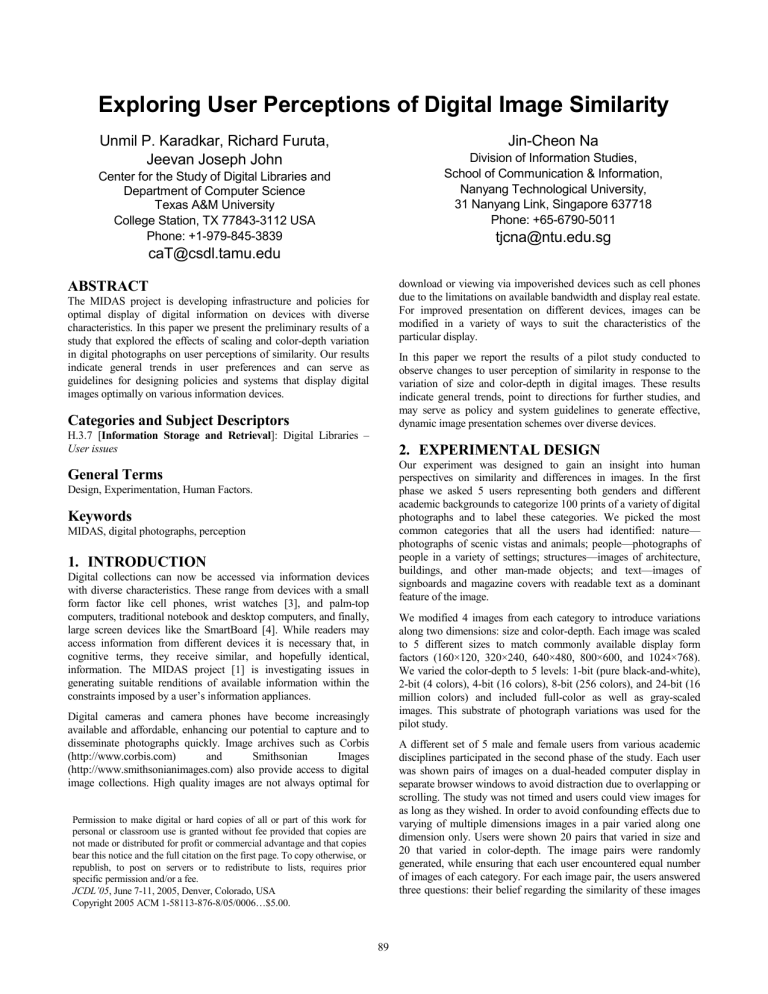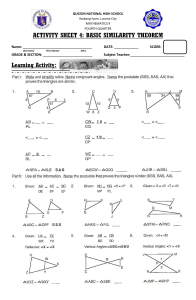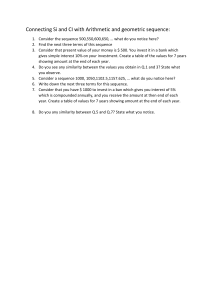
Exploring User Perceptions of Digital Image Similarity Unmil P. Karadkar, Richard Furuta, Jeevan Joseph John Jin-Cheon Na Division of Information Studies, School of Communication & Information, Nanyang Technological University, 31 Nanyang Link, Singapore 637718 Phone: +65-6790-5011 Center for the Study of Digital Libraries and Department of Computer Science Texas A&M University College Station, TX 77843-3112 USA Phone: +1-979-845-3839 tjcna@ntu.edu.sg caT@csdl.tamu.edu download or viewing via impoverished devices such as cell phones due to the limitations on available bandwidth and display real estate. For improved presentation on different devices, images can be modified in a variety of ways to suit the characteristics of the particular display. ABSTRACT The MIDAS project is developing infrastructure and policies for optimal display of digital information on devices with diverse characteristics. In this paper we present the preliminary results of a study that explored the effects of scaling and color-depth variation in digital photographs on user perceptions of similarity. Our results indicate general trends in user preferences and can serve as guidelines for designing policies and systems that display digital images optimally on various information devices. In this paper we report the results of a pilot study conducted to observe changes to user perception of similarity in response to the variation of size and color-depth in digital images. These results indicate general trends, point to directions for further studies, and may serve as policy and system guidelines to generate effective, dynamic image presentation schemes over diverse devices. Categories and Subject Descriptors H.3.7 [Information Storage and Retrieval]: Digital Libraries – User issues 2. EXPERIMENTAL DESIGN Our experiment was designed to gain an insight into human perspectives on similarity and differences in images. In the first phase we asked 5 users representing both genders and different academic backgrounds to categorize 100 prints of a variety of digital photographs and to label these categories. We picked the most common categories that all the users had identified: nature— photographs of scenic vistas and animals; people—photographs of people in a variety of settings; structures—images of architecture, buildings, and other man-made objects; and text—images of signboards and magazine covers with readable text as a dominant feature of the image. General Terms Design, Experimentation, Human Factors. Keywords MIDAS, digital photographs, perception 1. INTRODUCTION Digital collections can now be accessed via information devices with diverse characteristics. These range from devices with a small form factor like cell phones, wrist watches [3], and palm-top computers, traditional notebook and desktop computers, and finally, large screen devices like the SmartBoard [4]. While readers may access information from different devices it is necessary that, in cognitive terms, they receive similar, and hopefully identical, information. The MIDAS project [1] is investigating issues in generating suitable renditions of available information within the constraints imposed by a user’s information appliances. We modified 4 images from each category to introduce variations along two dimensions: size and color-depth. Each image was scaled to 5 different sizes to match commonly available display form factors (160×120, 320×240, 640×480, 800×600, and 1024×768). We varied the color-depth to 5 levels: 1-bit (pure black-and-white), 2-bit (4 colors), 4-bit (16 colors), 8-bit (256 colors), and 24-bit (16 million colors) and included full-color as well as gray-scaled images. This substrate of photograph variations was used for the pilot study. Digital cameras and camera phones have become increasingly available and affordable, enhancing our potential to capture and to disseminate photographs quickly. Image archives such as Corbis (http://www.corbis.com) and Smithsonian Images (http://www.smithsonianimages.com) also provide access to digital image collections. High quality images are not always optimal for A different set of 5 male and female users from various academic disciplines participated in the second phase of the study. Each user was shown pairs of images on a dual-headed computer display in separate browser windows to avoid distraction due to overlapping or scrolling. The study was not timed and users could view images for as long as they wished. In order to avoid confounding effects due to varying of multiple dimensions images in a pair varied along one dimension only. Users were shown 20 pairs that varied in size and 20 that varied in color-depth. The image pairs were randomly generated, while ensuring that each user encountered equal number of images of each category. For each image pair, the users answered three questions: their belief regarding the similarity of these images Permission to make digital or hard copies of all or part of this work for personal or classroom use is granted without fee provided that copies are not made or distributed for profit or commercial advantage and that copies bear this notice and the full citation on the first page. To copy otherwise, or republish, to post on servers or to redistribute to lists, requires prior specific permission and/or a fee. JCDL’05, June 7-11, 2005, Denver, Colorado, USA Copyright 2005 ACM 1-58113-876-8/05/0006…$5.00. 89 was displayed in full color. Table 3 displays user perception in response to changes in color-depth of images. In the first row (distance=0), the pair contained a color image and its gray-scaled version, both with the same color-depth. As expected, users found these pairs to be the most similar. The similarity scores dropped quickly as the disparity between image colors increased. Users were far less likely to permit automatic substitutions (30%) compared to image scaling (45%) but at the same time, demonstrated a higher confidence level for substitution when they recommended these (7.7 vs. 7.47 for scaled images). (on a scale of 1–9); whether they would let a computer program automatically replace one image with the other (yes or no); and the extent to which they favored replacing an image by another (on a scale of 1-9). Following the task, they provided additional feedback via free-form interviews. 3. ANALYSIS OF RESULTS To analyze the data, we calculated the non-weighted distance between the paired images by counting the number of steps between them. For example, an image of 640x480 pixels is separated from an image of 160x120 pixels by a distance of 2 units. The distance, thus, provides a measure of the degree of variation along a particular dimension. Table 3. Effects of variation in color-depth Distance Within color or gray-scale Color to gray-scale Table 1. Effects of scaling Overall Image replacement Distance Similarity Replace with warning Auto replacement 0 - 6.89 1 7.12 6.05 (56%) 7.66 (44%) 1 6.69 5.57 With warning: 4.27 (70%) 2 7.11 6.00 (51%) 7.42 (49%) 2 4.6 4.55 Automatic: 7.7 (30%) 3 6.87 6.50 (50%) 7.13 (50%) 3 5.86 4.00 4 4.14 - 4 6.14 4.18 (79%) 7.67 (21%) Overall - 5.73 (55%) 7.47 (45%) Interviews with users also helped us understand their preferences and biases. One user expected to be notified of image replacement regardless of how minor the difference in the images was. During the interviews, users echoed their preference for scaled images, which is consistent with the analysis of their on-task behavior. Table 1 shows the user response to change in image size (scaling). Decreasing numbers in the “Similarity” column indicate that the perceived similarity decreases with increasing image distance. Overall, in 55% of the cases users indicated that they would permit replacement of an image by the other if the computer system warned them regarding this change. While users approved of automatic substitutions of images in fewer cases (45%), they were more favorably inclined towards this possibility when they did approve of it, with a rating of 7.47 as opposed to 5.73. The potential for permitting automatic substitution dropped off sharply for images separated by large distances (21%). 4. FUTURE WORK While our results are not statistically significant due to the small sample size, they do indicate definite trends in user behavior that require further exploration. We are currently in the process of planning a more intensive study based on the lessons learnt from the pilot study described here. In general, users allocated lower similarity scores to images with different color-depth than with different sizes. These trends and user feedback can also influence system design. Providers of digital collections can implement policies that prefer scaling of images over color-variation to support optimal image representation on different information devices. Table 2. Similarity values for scaling by image categories Distance nature people structures text 1 6.57 7.17 7.67 6.78 2 7.33 7.09 6.78 7.25 3 7.75 7.00 7.00 6.29 4 7.00 5.71 7.50 5.00 5. REFERENCES [1] Karadkar, U., Furuta, R., Ustun, S., Park, Y., Na, J.-C., Gupta, User responses indicate that different categories of images can be scaled to various levels while retaining similarity. Table 2 presents category-based similarity values for image pairs. While images of natural elements and man-made structures scaled gracefully, those of people and textual content did not. This result is intuitive for textual images as text becomes unreadable when images are scaled down. Scaled images of people do not contain recognizable faces, resulting in a drop off in the similarity value for these pairs. This finding reaffirms results reported from other studies related to the behavior of people in online communities: “people are interested in other people” [2]. V., Ciftci, T. and Park, Y. Display-agnostic Hypermedia. In Proceedings of Hypertext 2004 (Santa Cruz CA, August 2004), ACM Press, 58-67. [2] Lee, A. and Girgensohn, A. Making Web Sites be Places for Social Interaction. In Proceedings of the 2002 ACM conference on Computer Supported Cooperative Work (New Orleans LA, November 2002), ACM Press, 136-145. [3] Raghunath, M.T., and Narayanaswami, C. User Interfaces for Applications on a Wrist Watch. In Personal and Ubiquitous Computing, 6(1) (2002) Springer Verlag, 17-30. [4] SMART Board Interactive WhiteBoard. Variation of color-depth consisted of two sub-cases. In one case, images in a pair were either both gray-scaled or both colored. These pairs were perceived to be closer to each other than for similar distances where one of the images was gray-scaled while the other http://www.smarttech.com/Products/smartboard/ (accessed February 2005) 90




